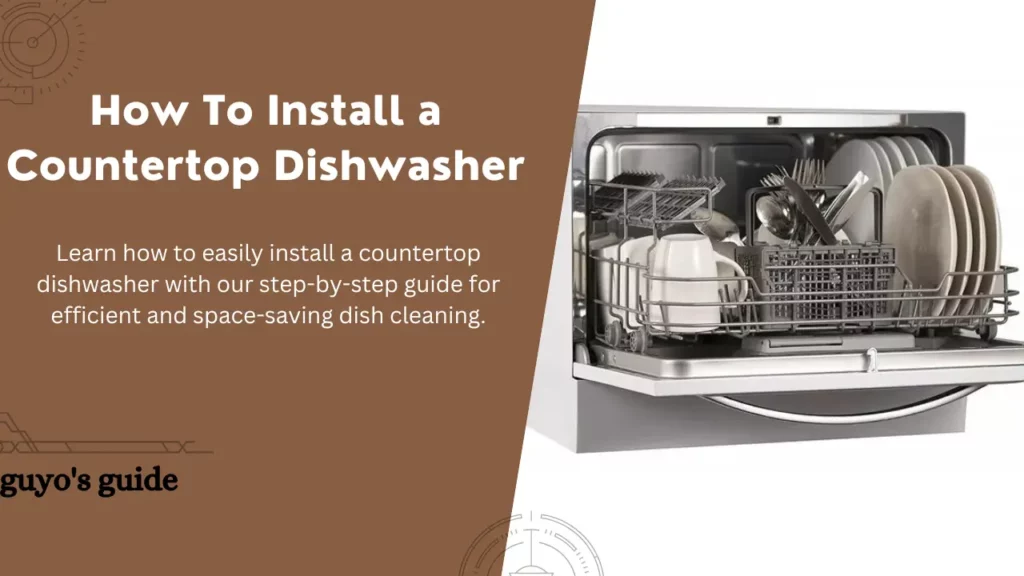How To Install a Countertop Dishwasher From Absolute Scratch


If you’ve recently purchased a countertop dishwasher or you’re considering adding one to your kitchen, you’ve come to the right place.
In this comprehensive guide, we’ll walk you through how to install a countertop dishwasher and provide step-by-step instructions to ensure a successful installation.
So, let’s get started.
Step-by-Step Process on How to Install a Countertop Dishwasher
Installing a countertop dishwasher is a relatively straightforward process, but it does require careful attention to detail. Below is a step-by-step guide to help you install a countertop dishwasher in your kitchen. Before you start, ensure you have all the necessary tools and materials.
Materials and Tools You’ll Need:
- Countertop dishwasher
- Sink faucet adapter or dishwasher installation kit
- Adjustable wrench or pliers
- Screwdriver
- Dishwasher hose
- Dishwasher inlet and outlet hoses
- Dishwasher mounting brackets (if required)
- Dishwasher detergent
- Level
- Electrical outlet (if your dishwasher requires it)
Step 1: Choose a Suitable Location

Select a location for your countertop dishwasher near your kitchen sink. Ensure there is enough space for the dishwasher, and it’s close to an electrical outlet if needed. Also, consider the placement of the water source and drain.
Step 2: Prepare the Area
Clear the area where you plan to install the dishwasher. Remove any items that may obstruct the installation process.
Step 3: Connect the Water Supply
- Attach the sink faucet adapter or dishwasher installation kit to your sink faucet. Follow the manufacturer’s instructions for your specific adapter type.
- Connect one end of the dishwasher inlet hose to the faucet adapter or kit, and tighten it using an adjustable wrench or pliers.
Step 4: Set Up the Drain
- Find a suitable location for the drain hose. You can often use the sink drain as long as it’s above the trap.
- Attach one end of the dishwasher drain hose to the dishwasher’s drain outlet. Ensure it is securely in place.
- Connect the other end of the drain hose to the drain-source you selected (e.g., sink drain, garbage disposal, or a separate air gap device if required).
Step 5: Level the Dishwasher
Use a level to make sure your countertop dishwasher is perfectly level. Adjust the height of the dishwasher’s legs if necessary to achieve this.
Step 6: Secure the Dishwasher
If your countertop dishwasher comes with mounting brackets, use them to secure the dishwasher to the countertop or adjacent cabinets. This helps prevent the dishwasher from moving during operation.
Step 7: Plug In the Dishwasher
If your countertop dishwasher requires electricity, plug it into a nearby electrical outlet. Ensure the outlet is grounded, and follow the manufacturer’s instructions for electrical requirements.
Step 8: Test the Dishwasher
Run a test cycle with an empty dishwasher to ensure it’s working properly and that there are no leaks in the water supply or drain connections.
Step 9: Load Dishes and Use
Once your countertop dishwasher is installed and tested, you can start using it to wash your dishes.
Make sure to follow the manufacturer’s instructions for your specific dishwasher model, including detergent recommendations and care and maintenance guidelines.
How To Maintain a Countertop Dishwasher After Installation
Maintaining a countertop dishwasher is crucial to ensure it continues to work efficiently and lasts a long time. Here are some maintenance tips to follow after installing your countertop dishwasher:
1. Regular Cleaning:
- Wipe down the interior of the dishwasher after each use to remove any food particles or debris.
- Clean the dishwasher’s filter or trap, if it has one, on a regular basis to prevent clogs.
- Use a dishwasher-safe cleaner to clean the exterior and the door, as well as any buttons or control panels.
2. Check and Clean Spray Arms:
- Periodically inspect the spray arms for clogs or obstructions. Remove any debris that might affect water flow.
- You can remove the spray arms (if they are detachable) for a more thorough cleaning.
3. Maintain the Drain
Regularly inspect the drain area for any blockages or debris. Remove any clogs to ensure proper drainage.
4. Run an Empty Cycle with Vinegar
Once a month or as needed, run a cycle with a cup of white vinegar in an empty dishwasher. This helps remove mineral deposits and keeps the dishwasher interior clean and odor-free.
5. Use Quality Detergent
Always use a good-quality dishwasher detergent recommended by the manufacturer. Avoid using regular dish soap, as it can cause excessive suds and damage the dishwasher.
6. Check the Water Supply
Inspect the water inlet hose for leaks or kinks. Make sure the water supply is secure, and there are no visible issues with the hose.
7. Inspect the Drain Hose
Periodically check the dishwasher’s drain hose for any leaks, kinks, or blockages. Ensure that it is properly connected to the drain source.
8. Maintain the Filter
If your dishwasher has a filter, clean or replace it according to the manufacturer’s instructions. A dirty filter can lead to poor cleaning performance.
9. Check Seals and Gaskets
Inspect the door gasket and any other seals for signs of wear or damage. Replace them if necessary to prevent leaks.
10. Prevent Hard Water Buildup
If you have hard water in your area, use a dishwasher cleaner or additive designed to combat mineral deposits. This helps prevent limescale buildup in your dishwasher.
11. Address Rust or Corrosion
If you notice any rust or corrosion inside the dishwasher, address it promptly. This may involve cleaning or, in severe cases, contacting the manufacturer for advice.
12. Consult the Owner’s Manual
Always refer to the manufacturer’s guidelines in the owner’s manual for specific maintenance instructions and recommended cleaning products.
13. Regularly Inspect for Leaks
Keep an eye out for any signs of leaks or water damage in the area around the dishwasher. Address any leaks immediately to prevent further damage.
FAQs
Do countertop dishwashers require professional installation?
No, countertop dishwashers are designed for easy installation and can typically be installed by homeowners without professional help. However, it’s essential to follow the manufacturer’s instructions for your specific model carefully.
Can I install a countertop dishwasher if I don’t have a dedicated water line?
Yes, countertop dishwashers are designed to be portable and can usually connect to a standard kitchen faucet. They come with a connector that attaches to the faucet, allowing them to draw water directly from the tap.
How long does it take to install a countertop dishwasher?
Installation times can vary depending on your familiarity with the process and the complexity of the model. On average, installation can take anywhere from 30 minutes to an hour.
Wrap Up
Installing a countertop dishwasher is a practical and convenient solution for small kitchens or those needing additional dishwashing space.
By following these few simple steps, you can enjoy the benefits of a dishwasher without the hassle of extensive plumbing or renovation.
Remember to carefully measure and choose a suitable location, connect the necessary hoses, and ensure proper drainage.
With a countertop dishwasher, you’ll save time and effort while keeping your kitchen clean and organized.
Cheers to effortless dishwashing!






